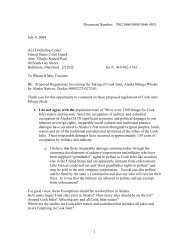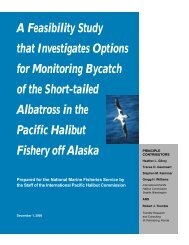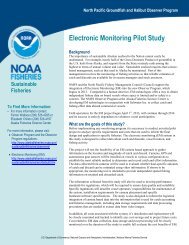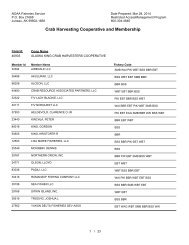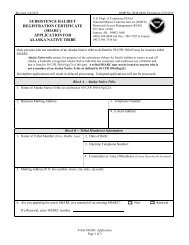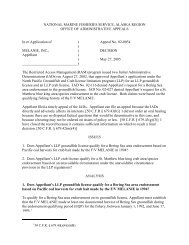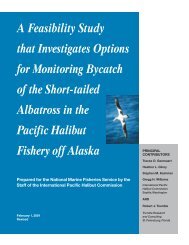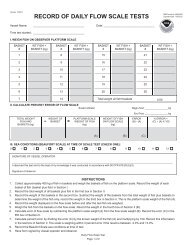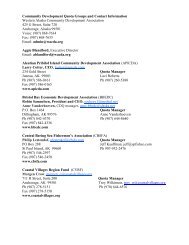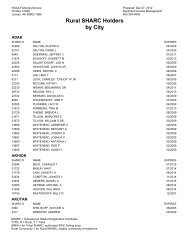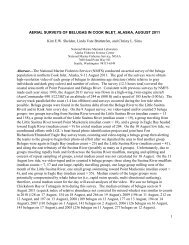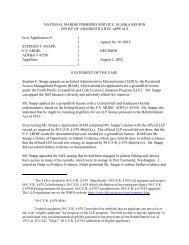Petition to List Lynn Canal Pacific Herring under the Endangered ...
Petition to List Lynn Canal Pacific Herring under the Endangered ...
Petition to List Lynn Canal Pacific Herring under the Endangered ...
Create successful ePaper yourself
Turn your PDF publications into a flip-book with our unique Google optimized e-Paper software.
NMFS (2005a) concluded that Berners Bay is critically important <strong>to</strong> <strong>the</strong> continued<br />
existence of <strong>the</strong> <strong>Lynn</strong> <strong>Canal</strong> <strong>Herring</strong> population. Citing <strong>the</strong> negative impacts <strong>to</strong> herring<br />
and <strong>the</strong>ir habitat, particularly <strong>the</strong> direct loss of spawning habitat, NMFS required <strong>the</strong><br />
action agencies, here <strong>the</strong> Federal Highway Administration (FHWA) and <strong>the</strong> U.S. Army<br />
Corps of Engineers (USACOE), <strong>to</strong> implement manda<strong>to</strong>ry mitigation and <strong>to</strong> reassess<br />
portions of <strong>the</strong> project. Prior <strong>to</strong> <strong>the</strong> initiation of formal consultation, NMFS made<br />
recommendations that were not well received by FHWA.<br />
In <strong>the</strong> December 3, 2004 letter, and during informal consultation meetings with<br />
<strong>the</strong> action agencies and applicant, NMFS recommended several measures <strong>to</strong> limit<br />
adverse effects <strong>to</strong> listed marine mammals in Berners Bay and alleviate <strong>the</strong> need<br />
for formal section 7 consultation. Namely, <strong>the</strong>se consisted of avoiding usage of<br />
Berners Bay al<strong>to</strong>ge<strong>the</strong>r and proceeding with previously permitted helicopter<br />
transport; or, if transiting Berners Bay, using an alternate dock location <strong>to</strong><br />
Cascade Point and suspending vessel operations during <strong>the</strong> spring<br />
eulachon/herring runs. As <strong>the</strong> action agencies and applicant did not accept <strong>the</strong>se<br />
recommendations, formal consultation was initiated on November 17, 2004,<br />
pursuant <strong>to</strong> <strong>the</strong> request received on November 17, 2004.<br />
(NMFS 2005: 5). In a NMFS summary attached <strong>to</strong> <strong>the</strong> formal consultation letter, <strong>the</strong><br />
agency made it clear that <strong>the</strong> entire Berners Bay ecosystem would suffer damage from <strong>the</strong><br />
mine developments, emphasizing <strong>the</strong> vulnerability and importance of <strong>the</strong> <strong>Pacific</strong> <strong>Herring</strong>.<br />
The following are NMFS concerns as expressed orally in meetings with <strong>the</strong> action<br />
agency and applicant during informal ESA consultation. In addition, NMFS<br />
outlines recommended measures here as acceptable alternatives <strong>to</strong> <strong>the</strong> proposed<br />
action. The recommendations included here would be <strong>the</strong> necessary mitigation<br />
for NMFS <strong>to</strong> agree with <strong>the</strong> ‘not likely <strong>to</strong> adversely affect’ conclusion drawn by<br />
<strong>the</strong> action agency. This discussion also responds <strong>to</strong> <strong>the</strong> mitigation measures<br />
proposed in <strong>the</strong> joint USFS and ACOE BA/BE, many of which are important in<br />
order <strong>to</strong> reduce impacts <strong>to</strong> marine mammals but would require fur<strong>the</strong>r<br />
precautionary activities, time or area constraints, or additional complementary<br />
measures <strong>to</strong> adequately reduce risk.<br />
(NMFS 2005a). Fur<strong>the</strong>r impacts on herring will result from <strong>the</strong> daily operations and<br />
required travel of mine workers. NMFS noted this as an additional consequence of <strong>the</strong><br />
mine:<br />
The proposed crew shuttle route across <strong>the</strong> bay, an almost straight line from<br />
Cascade Point <strong>to</strong> <strong>the</strong> Slate Creek Cove terminal site, will take <strong>the</strong> ferry directly<br />
through areas where large schools of eulachon and herring are known <strong>to</strong> aggregate<br />
prior <strong>to</strong> spawning in March and April. Individual adult herring and eulachon<br />
schools are likely <strong>to</strong> be exposed <strong>to</strong> vessel activities repeatedly throughout <strong>the</strong><br />
spring months as <strong>the</strong> schools stage along <strong>the</strong> shoreline near Slate Creek Cove and<br />
Cascade Point in preparation for spawning.<br />
44



